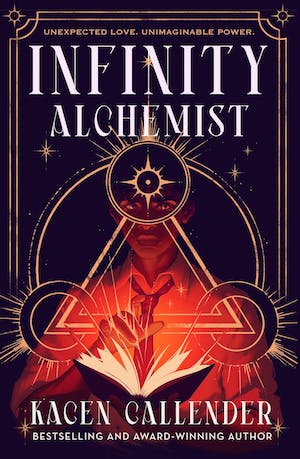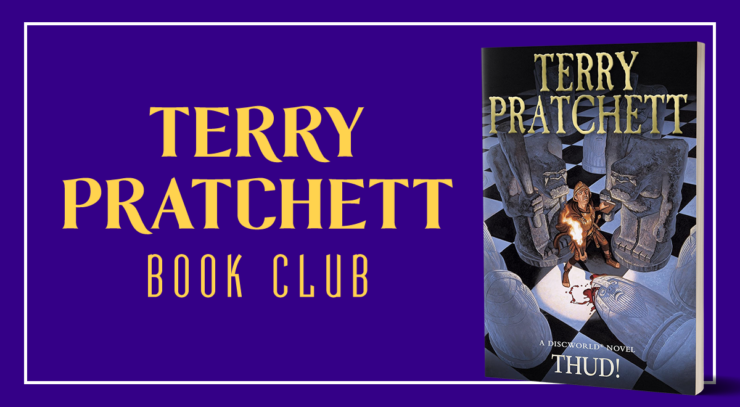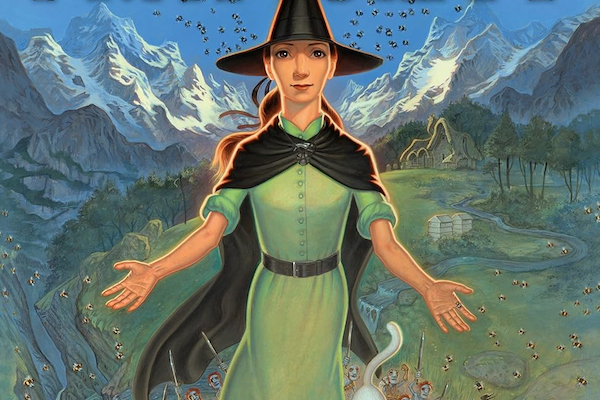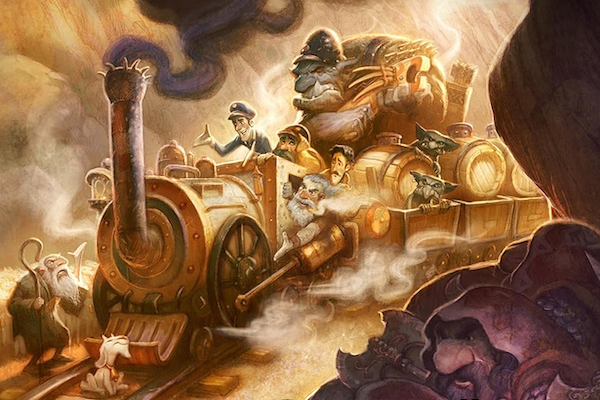What sort of dark do you have to worry about? I reckon mine is a Bumbling Dark…
Summary
Vimes, Sir Reynold, and Sybil head into the Ramkin family attics and find Sybil’s replica of The Battle of Koom Valley. As they’re looking over it, Vimes realizes that the deep-down dwarfs believe that the painting is a map that will lead them to something important. He decides he’s going to Koom Valley and Sybil insists on coming along with Young Sam despite his protestations. Vimes tells Vetinari that he’s doing this with a crew of officers and Bashfullsson, and cannot be dissuaded. He secretly meets with Ridcully and asks if there’s anything the wizards can do to help his party get to Koom Valley faster since they’re a day behind the dwarfs. Ridcully agrees that he can do something to their coaches and that they obviously never had this conversation. Vimes wakes in the morning and Carrot informs him that the wizards have altered the carriages so that they weigh literally nothing, even with passengers. The horses have also been given some help with special harnesses. Detritus gets permission to take Brick along. The coaches set off, and when the harnesses for the horses kick into gear, the carriages lift off the ground and manage to hit sixty miles per hour.
Buy the Book


Infinity Alchemist
After going at that pace for a short burst, Vimes manages to stop the carriages and get them back to a normal speed, but Willikins points out that they could get to Koom Valley that day if they kept it up and that the dwarfs likely had brooms or some other fast mode of transit. They make it to twenty miles outside, but Sybil insists that they go the rest of the way normally so everyone can get rest in town and be fresh the following day. They stay with an old friend of Sybil’s named Bunty. She doesn’t consider trolls to be people of any sort, though Detritus takes this in stride. Angua and Sally are asked to bunk together and Sally leaves in the middle of the night. The next day the group head into the valley with the sketch of the painting, but Vimes is having a hard time matching up the landscape until he accidentally sits on the real painting. He finds a cave entrance and knows that this is where the cube was found. He also knows that there’s a tunnel below and decides to investigate before everyone else catches up to him, dropping into water below. He comes to on a dark beach in the cave and knows he must press on, despite the fact that he’d only come this far because of the voice in his head that told him to jump down into the cave.
Vimes is having a near death experience (which Death shows up for) as Sybil assures her friend that he will be home to read to Young Sam soon. The Gooseberry tells Vimes that he only has a few minutes to get back, and Vimes latches onto that to keep going. He comes upon a mine with dwarfs and is no longer himself, but a creature demanding of the dwarfs: Where’s my cow? Far away, Young Sam can hear him. He hones in on his target as the dwarfs scrabble to stop him and Sally arrives to help. Eventually, Vimes reaches his target… and stops. Inside Vimes, the Summoning Dark meets Vimes’ inner Watchman, and he tells the Summoning Dark to beat it. He comes to having been tackled by Angua, and surrounded by the Low King’s dwarfs. The deep-downers had been destroying this site where trolls and dwarfs had died side by side. Bashfullson explains that Vimes was possessed by the Summoning Dark, but he managed to beat it. Vimes goes to see his officers and tells the Low King’s captain that Detritus and Brick are to be better treated. The captain agrees to this when he sees the Summoning Dark symbol etched on Vimes as a scar. King Rhys arrives and learns that his men haven’t found the cube. Vimes has a hunch and tells Nobby to hand it over.
Rhys wants the cube, but balks when Vimes tells him to take it. He figures out the opening word (the dwarf word for “say” that sounds like “Awk!”), and the cube begins by speaking Things Tak Wrote… only the ending is different and suggests that dwarfs created the trolls and found them very good indeed. Then the voice of B’hrian Bloodaxe tells the tale: The cave was flooded and they won’t make it out, but dwarfs and trolls came here to make peace, and then someone shouted ambush and a fight broke out. They want the world to know that they brokered that treaty and dwarf and troll died side by side. Ardent is furious and insists it’s a hoax, and goes to fight Bashfullsson for lies; he’s quickly dispatched. Trolls have arrived to parley, and Rhys agrees to see them. Trolls and dwarfs work quickly to preserve the scene, then plan to seal it up. Vimes takes Sally aside and confronts her about being a spy for Rhys, but insists on keeping her. Sybil takes Vimes for their family portrait, finally: She has Otto take their picture. Carrot shows Vetinari the mines under the city, which now belong to Ankh-Morpork. Nobby decides to break up with Tawneee, Brick has a new watchman job, and Vimes reads his book to Young Sam.
Commentary
If I’m not mistaken, this is the first time Pratchett has created a mystical entity and admitted to what it was before the main character was properly introduced. Usually it’s all “the thing/being/creature did such-and-so” for every passage until the relevant person comes into direct contact with it. But in this instance, once Vetinari insists that Ridcully thinks that Summoning Dark is a real entity, it’s named in the next section from its vantage point. Almost as though either the Chancellor or the Patrician’s vote of confidence is enough to tell the reader, yeah, that’s definitely what it is, we’re going with that.
Sam Vimes is running on fumes as always, but this time he’s possessed by the Summoning Dark, and mad with grief at the thought of not being able to read to his son at six. The setup on that climax is admittedly flawless, and so much more interesting than your usual rampage sequence all because they’ve managed to fuel Vimes’ rage with something that truly does matter more than anything in the world—his love for his son.
Which is interesting because it means that you can’t really write this particular story until Vimes is a father. His relationship with Sybil wouldn’t have this hold; Sam Vimes loves his wife, but he’s very practical about that love. Young Sam is the one he’s pinned all his expectations onto. Sybil loves him in turn for all of his mess, but with his child, there’s an ideal that he needs to live up to.
It’s telling that for Vimes, the last two books have basically been about the same thing—they’re marking out that line where his morality lives and asking if a cop can stay above corruption. I’d argue that the need for this conversation springs directly from Vimes’ actions in The Fifth Elephant, and proceeds in a straight line. And the answer is roughly the same on both tales: most of the time. The difference is that this book makes that ability to watch himself a manner of superpower… which is cool from a storytelling perspective, but maybe less impressive from a realism standpoint. The idea of other people keeping an eye on Sam Vimes is still important, no matter what line he’s holding for himself. He needs Sybil and Carrot and Angua and Vetinari for that.
I do love that it’s not difficult for Vimes to write off the Summoning Dark at all. People believe what they want to, even—or maybe especially—when they’re being possessed by ancient supernatural entities.
The other part of the tale is zeroed in on how far people will go to perpetuate their prejudices and cultural givens. And again, it’s made a point of (more than once) how horribly Detritus (and Brick by extension) is treated and how much of that treatment he takes on the chin. The hunting trophies at the embassy in Bonk are sprung on everyone in The Fifth Elephant, but here we have a school pal of Sybil’s essentially treat Detritus like an animal. He’s the one who defuses the situation, and by doing so, prevents Vimes and Sybil from having to say anything on his behalf. In many ways this almost reads like both a self-own and sharp audience check on Pratchett’s part—we get this far along in the series and he turns around and points out that the reader probably has some notions about troll ability and intelligence based on the way he’s written them.
And with all that said and done, it’s time for another story. Possibly a long nap, too.
Asides and little thoughts:
- About Sybil’s family attics: “Maybe that was the reason for their wealth: they had bought things that were built to last, and now they seldom had to buy anything at all.” I’ve talked a bit about this before, but as an addendum to Vimes’ Boots Theory, this is completely accurate to how “old money” thinking works: If you’ve got quality and space to keep it, you are likely to always have what you need indefinitely. Unfortunately, “new money” seems to have largely embraced the capitalist consumerism message of “just buy more stuff and throw away the old stuff.”
- Look, I really love the phrase “mad as a spoon” because it inevitably forces me to consider what makes the spoon mad, and I wind up thinking things like “it’s having a bowl, isn’t it,” which is exactly the sort of thought I want to be having about phrases like “mad as a spoon.”
- There’s also a description of a rocking horse that’s “all teeth and mad glass eyes” and I know exactly the one he means.
Pratchettisms:
Difficult reading, too, because a lot of them were half-burned, and in any case Rascal’s handwriting was what might have been achieved by a spider on a trampoline during an earthquake.
And that was his life: one huge oblong of canvas. Methodia Rascal: born, painted famous picture, thought he was a chicken, died.
He heard a brief scream as the rear coach tore past and swerved into a field full of cauliflowers where, eventually, it squelched to a flatulent halt.
With that, Sam Vimes walked back to the milestone, sat down next to it, put his arms around it, and held on tight until he felt better.
His ribs were carrying the melody of pain, but knees, elbows, and head were all adding trills and arpeggios.
He shuffled on, aching and bleeding, while the dark curled its tail around him.
HAS IT NEVER STRUCK YOU THAT THE CONCEPT OF THE WRITTEN NARRATIVE IS SOMEWHAT STRANGE? said Death.
Vimes thought that was a bit too pat, but nature can be like that. Sometimes you got sunsets so pink that they had no style at all.
We’re gonna pause for the next two weeks, and then we’re back with Wintersmith! We’ll read Chapters 1-4.












